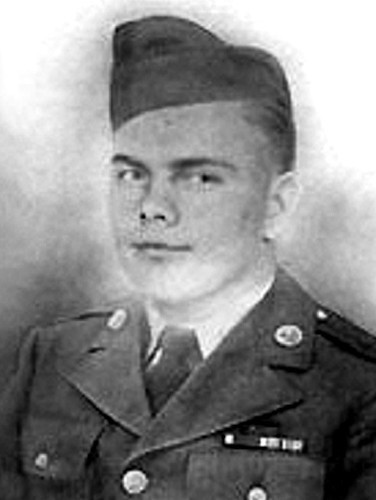Leonard C. Brostrom
Leonard C. Brostrom was a United States Army infantry soldier who was killed during World War II. He received the Medal of Honor posthumously for his heroic actions.
Brostrom was born on November 23, 1919, in Preston, Idaho, where he grew up. After graduating from Preston High School, he served as a missionary in California for The Church of Jesus Christ of Latter-day Saints. While serving his mission, the United States declared war on Japan. Brostrom completed his mission and then enlisted in the Army in March 1942.
He completed basic training at Fort Ord, California. His motorized division began training under the U.S. Marines in the Mojave Desert for deployment to the African theater. His division was renamed and began training for amphibious assault training to be deployed in the Pacific theater.
He was assigned to Company F, 2nd Battalion, 17th Infantry Regiment, 7th Infantry Division and participated in the amphibious assaults and retaking of the Aleutian Islands, Eastern Mandates, and Leyte.
While in Leyte on October 28, 1944, Brostrom’s lead assault platoon encountered enemy fire. The Japanese soldiers were well entrenched and camouflaged. He was hit three times as he fought his way through a bamboo thicket. As he threw several grenades into an enemy bunker, six Japanese soldiers charged with bayonets. Brostrom killed one and wounded others, causing a retreat. Brostrom was hit a fourth time and fell, but rose again and continued to fire and throw grenades until the Japanese fled the bunker. Brostrom later succumbed to his wounds.
He was buried in the Preston Cemetery.
His citation read:
- He was a rifleman with an assault platoon which ran into powerful resistance near Dagami, Leyte, Philippine Islands, on 28 October 1944. From pillboxes, trenches, and spider holes, so well camouflaged that they could be detected at no more than 20 yards, the enemy poured machinegun and rifle fire, causing severe casualties in the platoon. Realizing that a key pillbox in the center of the strong point would have to be knocked out if the company were to advance, Pfc. Bostrom, without orders and completely ignoring his own safety, ran forward to attack the pillbox with grenades. He immediately became the prime target for all the riflemen in the area, as he rushed to the rear of the pillbox and tossed grenades through the entrance. Six enemy soldiers left a trench in a bayonet charge against the heroic American, but he killed 1 and drove the others off with rifle fire. As he threw more grenades from his completely exposed position he was wounded several times in the abdomen and knocked to the ground. Although suffering intense pain and rapidly weakening from loss of blood, he slowly rose to his feet and once more hurled his deadly missiles at the pillbox. As he collapsed, the enemy began fleeing from the fortification and were killed by riflemen of his platoon. Pfc. Brostrom died while being carried from the battlefield, but his intrepidity and unhesitating willingness to sacrifice himself in a l-man attack against overwhelming odds enabled his company to reorganize against attack, and annihilate the entire enemy position.
His other decorations and awards include, Combat Infantryman Badge, Expert Rifle Marksmanship Badge, Purple Heart, Army Presidential Unit Citation, Army Good Conduct Medal, American Campaign Medal, Asiatic-Pacific Campaign Medal with Arrowhead device and two 3/16” bronze stars, World War II Victory Medal, and Philippine Liberation Medal.
A United States Army transport ship, USAT Private Leonard C. Brostrom, was named after him in 1948.
In the early 1950s, Brostrom's Medal of Honor was donated by his family to the Franklin County Courthouse in Preston, where it was displayed with his picture and a few mementos.
According to Wikipedia:
- When a new set of county commissioners decided to remove the display cases, the local American Legion post then displayed Brostrom's Medal of Honor. In time, local veterans dwindled and the Legion Hall was taken over by the County. The last commander of the Preston American Legion Chapter in Preston then took Brostrom's display home for safe keeping. By this time, all of Brostrom's family had died except for a niece, who did not want the Medal of Honor display, citing that she would not be able to preserve it properly. A local lawyer, Jay MacKenzie, was asked to keep the display safe in his office. The medal sat there until a retired U.S. Army lieutenant colonel, Sherman L. Fleek, who was then the command historian for the United States Military Academy at West Point and doing research on Pfc. Brostrom's life, called MacKenzie. This eventually led to a discussion of how to properly honor Brostrom and display his Medal of Honor. Since Brostrom had been a lifetime member of The Church of Jesus Christ of Latter-day Saints, the Church History Library was contacted and agreed to preserve and display the medal there.[1]
